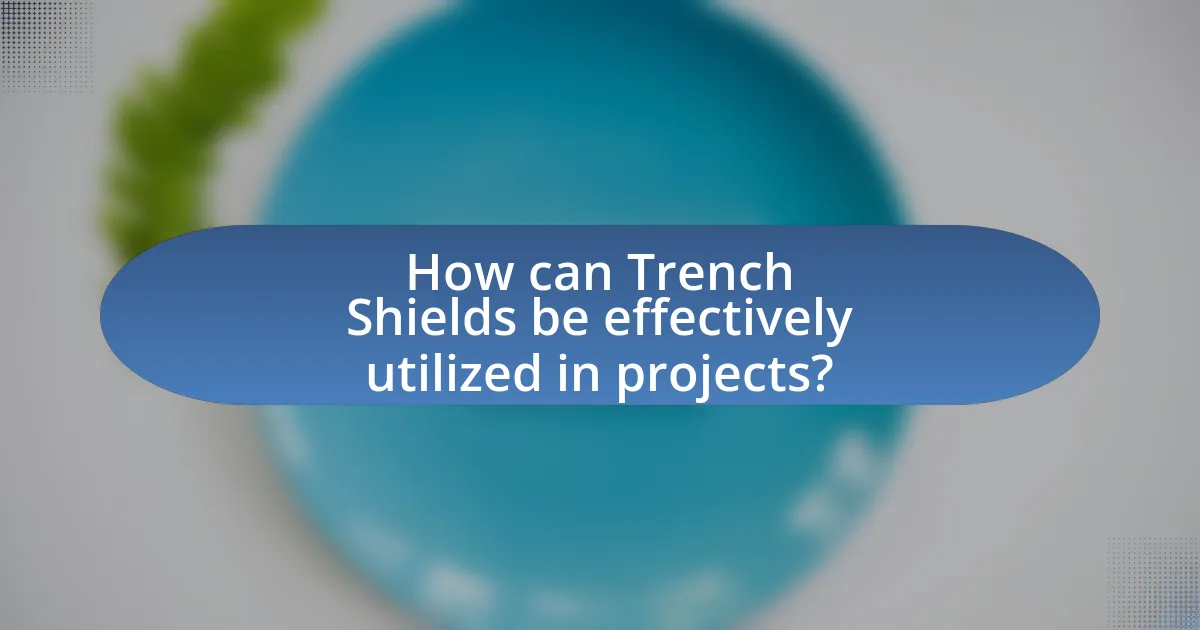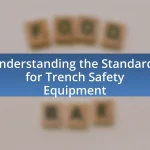Trench shields are essential protective structures used in excavation sites to prevent soil collapse and ensure worker safety. This article provides a comprehensive overview of trench shields, including their function, materials, and the various types available, such as hydraulic, aluminum, and steel shields. It highlights the importance of proper installation and maintenance, the benefits of using trench shields in reducing accidents and costs, and the factors influencing their selection based on soil conditions and trench depth. Additionally, the article addresses common challenges and mistakes associated with trench shield usage, offering best practices to enhance safety and efficiency in excavation projects.

What are Trench Shields?
Trench shields are protective structures used in excavation sites to prevent soil collapse and protect workers. These shields are typically made of steel or aluminum and are designed to provide a safe working environment in trenches by supporting the walls and preventing cave-ins. According to the Occupational Safety and Health Administration (OSHA), trench shields are essential for any excavation deeper than five feet, as they significantly reduce the risk of injury or fatality associated with trench collapses.
How do Trench Shields function in excavation projects?
Trench shields function by providing a protective barrier that supports the walls of an excavation site, preventing soil collapse and ensuring worker safety. These shields are typically made of steel or aluminum and are designed to be placed in the trench before excavation begins. They create a safe working environment by allowing workers to operate within the trench without the risk of cave-ins, which can occur due to the weight of surrounding soil. According to the Occupational Safety and Health Administration (OSHA), proper use of trench shields can significantly reduce the risk of accidents, as they are engineered to withstand the lateral pressure exerted by the soil.
What materials are commonly used in the construction of Trench Shields?
Trench shields are commonly constructed using materials such as steel, aluminum, and reinforced plastic. Steel is favored for its strength and durability, allowing it to withstand significant loads and pressures from surrounding soil. Aluminum is lighter than steel, making it easier to transport and handle while still providing adequate protection. Reinforced plastic is used for its corrosion resistance and lightweight properties, suitable for less demanding applications. These materials ensure that trench shields effectively protect workers from cave-ins and other hazards during excavation activities.
How do Trench Shields protect workers during excavation?
Trench shields protect workers during excavation by providing a structural barrier that prevents soil collapse and cave-ins. These shields are designed to withstand the lateral pressure exerted by the surrounding earth, ensuring that workers can operate safely within the excavation site. According to the Occupational Safety and Health Administration (OSHA), trench shields must meet specific engineering standards to effectively safeguard workers, thereby reducing the risk of injury or fatality associated with trench-related accidents.
What are the key benefits of using Trench Shields?
Trench shields provide essential protection for workers in excavation sites by preventing soil collapse and ensuring safety. These protective barriers are designed to support the walls of trenches, significantly reducing the risk of accidents and fatalities associated with trenching operations. According to the Occupational Safety and Health Administration (OSHA), trench collapses can be fatal, with over 100 deaths reported annually in the United States due to such incidents. By using trench shields, companies can comply with safety regulations, enhance worker confidence, and minimize downtime caused by accidents, ultimately leading to increased productivity and reduced liability costs.
How do Trench Shields enhance safety on job sites?
Trench shields enhance safety on job sites by providing structural support to excavations, preventing soil collapse and protecting workers from potential hazards. These protective barriers are designed to withstand the lateral pressure of surrounding soil, significantly reducing the risk of trench-related accidents. According to the Occupational Safety and Health Administration (OSHA), trench collapses can occur within seconds, and using trench shields can mitigate this risk, as they are engineered to meet safety standards and regulations. By effectively stabilizing the excavation walls, trench shields ensure a safer working environment for personnel involved in underground construction activities.
What cost savings can be achieved through the use of Trench Shields?
Trench shields can achieve significant cost savings by reducing the risk of accidents and associated liabilities, as well as minimizing the need for extensive excavation support systems. By providing immediate protection for workers in trenches, trench shields decrease the likelihood of injuries, which can lead to costly medical expenses and legal fees. According to the Occupational Safety and Health Administration (OSHA), trench collapses can result in fines and increased insurance premiums, which trench shields help to mitigate. Additionally, using trench shields can expedite project timelines, leading to lower labor costs and increased productivity, as workers can operate more efficiently in a safer environment.

What are the Different Types of Trench Shields?
The different types of trench shields include hydraulic trench shields, aluminum trench shields, and steel trench shields. Hydraulic trench shields are designed to provide support while allowing for quick installation and removal, making them suitable for various soil conditions. Aluminum trench shields are lightweight and easy to transport, offering effective protection in shallow excavations. Steel trench shields are robust and durable, ideal for deeper trenches and heavy-duty applications. Each type serves specific needs based on excavation depth, soil type, and project requirements, ensuring safety and compliance with regulations.
How do the types of Trench Shields differ from one another?
Trench shields differ primarily in their design, material, and application. For instance, steel trench shields are robust and suitable for heavy-duty applications, while aluminum trench shields are lighter and easier to transport, making them ideal for smaller jobs. Additionally, modular trench shields can be assembled in various configurations to accommodate different trench sizes and depths, providing versatility in construction projects. These differences are crucial for ensuring safety and efficiency in excavation work, as each type of trench shield is engineered to meet specific environmental and operational requirements.
What are the characteristics of standard Trench Shields?
Standard trench shields are designed to provide protection against soil collapse during excavation work. These shields typically feature a robust, steel construction that ensures structural integrity and durability. They are often equipped with sidewalls that are reinforced to withstand lateral earth pressures, and their design allows for easy installation and removal. Standard trench shields also come in various sizes to accommodate different trench depths and widths, ensuring versatility for various excavation projects. Additionally, they often include safety features such as access points for workers and are compliant with safety regulations to minimize risks associated with trenching operations.
What makes modular Trench Shields unique?
Modular trench shields are unique due to their customizable design, allowing for various configurations to fit different excavation needs. This adaptability enables contractors to efficiently manage diverse site conditions and depths, enhancing safety and operational efficiency. Additionally, modular trench shields are typically lighter and easier to transport compared to traditional, single-piece shields, which facilitates quicker setup and dismantling on job sites. The ability to combine multiple units also allows for increased flexibility in trench dimensions, accommodating a wide range of projects while maintaining compliance with safety regulations.
What factors should be considered when choosing a Trench Shield type?
When choosing a trench shield type, factors such as soil conditions, depth of excavation, load requirements, and site-specific regulations must be considered. Soil conditions influence the shield’s design, as cohesive or granular soils may require different support systems. The depth of excavation determines the shield’s height and structural integrity, while load requirements ensure the shield can withstand lateral earth pressures and any additional loads from above. Additionally, compliance with local regulations and safety standards is crucial to ensure worker safety and legal adherence.
How does the depth of the trench influence the choice of Trench Shield?
The depth of the trench directly influences the choice of Trench Shield by determining the required strength and design specifications to ensure worker safety. Deeper trenches, typically exceeding five feet, necessitate more robust trench shields that can withstand greater lateral earth pressures and potential soil movement. For instance, OSHA regulations stipulate that trenches deeper than five feet must be protected by a trench shield or other protective systems to prevent collapses, which can occur due to the increased weight of the soil above. Therefore, the selection of a trench shield must align with the trench depth to comply with safety standards and effectively mitigate risks associated with deeper excavations.
What soil conditions affect the selection of Trench Shields?
Soil conditions that affect the selection of trench shields include soil type, moisture content, and stability. Different soil types, such as clay, sand, or silt, influence the required strength and design of the trench shield. For instance, cohesive soils like clay may require shields with greater lateral support due to their tendency to retain water and become unstable when saturated. Conversely, granular soils like sand may require shields designed to prevent collapse due to their loose structure. Additionally, high moisture content can lead to increased pressure on the shield, necessitating a more robust design. Stability assessments, including the presence of groundwater or nearby structures, also play a critical role in determining the appropriate trench shield to ensure safety and compliance with regulations.

How can Trench Shields be effectively utilized in projects?
Trench shields can be effectively utilized in projects by providing essential protection against soil collapse during excavation work. These devices are designed to create a safe working environment by supporting the walls of trenches, thereby preventing accidents and injuries. According to the Occupational Safety and Health Administration (OSHA), using trench shields significantly reduces the risk of cave-ins, which are a leading cause of fatalities in excavation operations. Proper installation and adherence to safety guidelines ensure that trench shields function optimally, safeguarding workers and maintaining project timelines.
What are the best practices for installing Trench Shields?
The best practices for installing trench shields include ensuring proper site assessment, selecting the appropriate shield type, and following manufacturer guidelines. Conducting a thorough site assessment helps identify soil conditions and potential hazards, which informs the choice of trench shield. Selecting the appropriate type of trench shield, such as hydraulic or modular, is crucial for effective protection. Following manufacturer guidelines ensures that the installation meets safety standards and operational efficiency. Additionally, regular inspections during installation and use are essential to maintain safety and compliance with regulations.
How can proper installation of Trench Shields prevent accidents?
Proper installation of trench shields can prevent accidents by providing essential support and protection against soil collapse during excavation work. When trench shields are correctly positioned and secured, they create a safe working environment by effectively holding back the surrounding earth, which reduces the risk of cave-ins that can lead to serious injuries or fatalities. According to the Occupational Safety and Health Administration (OSHA), proper use of trench shields can decrease the likelihood of accidents by ensuring that excavations are stable and compliant with safety regulations.
What maintenance is required for Trench Shields during use?
Trench shields require regular inspections and cleaning during use to ensure safety and functionality. Inspecting for any signs of damage, such as cracks or deformation, is essential to maintain structural integrity. Additionally, cleaning the shields to remove dirt, debris, and any hazardous materials helps prevent corrosion and ensures visibility of safety markings. Regular maintenance checks should be documented to track the condition of the trench shields and ensure compliance with safety regulations.
What common challenges arise when using Trench Shields?
Common challenges when using trench shields include improper installation, which can lead to soil collapse, and difficulty in maneuvering the shields in tight spaces. Additionally, the weight of the shields can complicate transportation and handling, increasing the risk of injury. According to the Occupational Safety and Health Administration (OSHA), inadequate training on the use of trench shields can result in unsafe practices, further exacerbating these challenges.
How can issues with soil stability impact Trench Shield effectiveness?
Issues with soil stability can significantly reduce the effectiveness of trench shields by increasing the risk of soil collapse and undermining the shield’s structural integrity. When soil is unstable, it may not provide adequate support, leading to potential failure of the trench shield, which is designed to protect workers from cave-ins. According to the Occupational Safety and Health Administration (OSHA), approximately 75% of trench-related fatalities occur due to collapses, highlighting the critical importance of soil stability in ensuring the safety and functionality of trench shields.
What are the common mistakes to avoid when using Trench Shields?
Common mistakes to avoid when using trench shields include improper installation, neglecting to assess soil conditions, and failing to follow safety regulations. Improper installation can lead to shield failure, risking worker safety; for instance, not securing the shields adequately can result in collapse. Neglecting soil assessment may cause misjudgment of the required shield type, as different soil conditions necessitate specific designs to ensure stability. Additionally, failing to adhere to safety regulations, such as those outlined by OSHA, can lead to legal repercussions and increased risk of accidents on-site.
What tips can enhance the use of Trench Shields in excavation projects?
To enhance the use of Trench Shields in excavation projects, ensure proper installation and maintenance of the shields. Proper installation involves selecting the right size and type of trench shield based on soil conditions and excavation depth, which can prevent collapses and ensure worker safety. Regular maintenance, including inspections for wear and damage, is crucial as it helps identify potential issues before they lead to failures. According to OSHA regulations, using trench shields that meet safety standards significantly reduces the risk of accidents, thereby improving overall project efficiency and safety.


